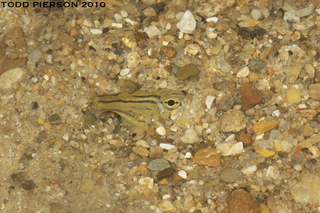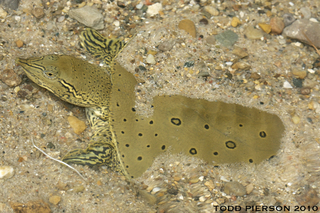 While geocaching on July 12, Stephanie and Rachel found this softshell below one of the Cedar Lakes dam's spillway after a rain. I worried that it would be in danger as the grass dried in the 35oC temperature (and as the grounds crew began mowing), so Rachel placed it back in an aquatic environment.
While geocaching on July 12, Stephanie and Rachel found this softshell below one of the Cedar Lakes dam's spillway after a rain. I worried that it would be in danger as the grass dried in the 35oC temperature (and as the grounds crew began mowing), so Rachel placed it back in an aquatic environment. On July 15 we found an even smaller softshell in the recently mowed grass heading uphill and across the road to one of the lakes. I made the decision to accelerate it's journey because of the roadway. The lake had a few very large snapping turtles - we noticed a few geese with missing feet and broken legs - but the lake certainly seemed safer for an aquatic turtle than a road.
On July 15 we found an even smaller softshell in the recently mowed grass heading uphill and across the road to one of the lakes. I made the decision to accelerate it's journey because of the roadway. The lake had a few very large snapping turtles - we noticed a few geese with missing feet and broken legs - but the lake certainly seemed safer for an aquatic turtle than a road. During college I worked with Florida Soft-shelled Turtles at ZooAmerica, and apparently the Eastern Spiny Softshell is just as fast, and similarly aggressive as a hunter. Its shell is smooth except for the small spines on the front of it's shell that give it's name. The spots also seem to distinguish it from the smooth softshell also found in parts of the Ohio river watershed.
It is primarily a river turtle, and it likes to bury itself in the sand or sandy gravel or mud of river bottoms with only it's snout visible (see photos below).
Most interesting to me is that it can get oxygen from the water. Its embryonic pharyngeal gill slits (which all vertebrates have) become a highly vascular pharynx with a lining thin enough to remove oxygen from the water. I haven't found a diagram or image of this yet. If you find one, add a link in the comments below.
Like other aquatic turtles, it buries its eggs on river banks exposed to the sun; but unlike other turtles, the egg development is not temperature dependent.
Great aquarium photos of A. spinifera burying itself:
 | |


No comments:
Post a Comment
Comments are moderated for SPAM (or trolls); otherwise all comments will be welcome.